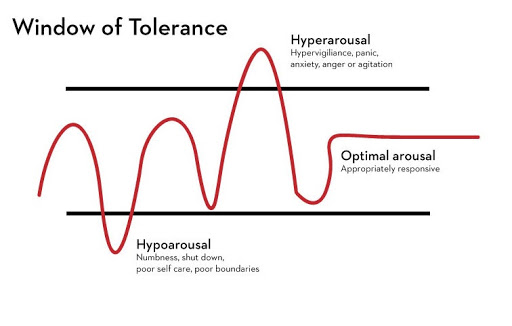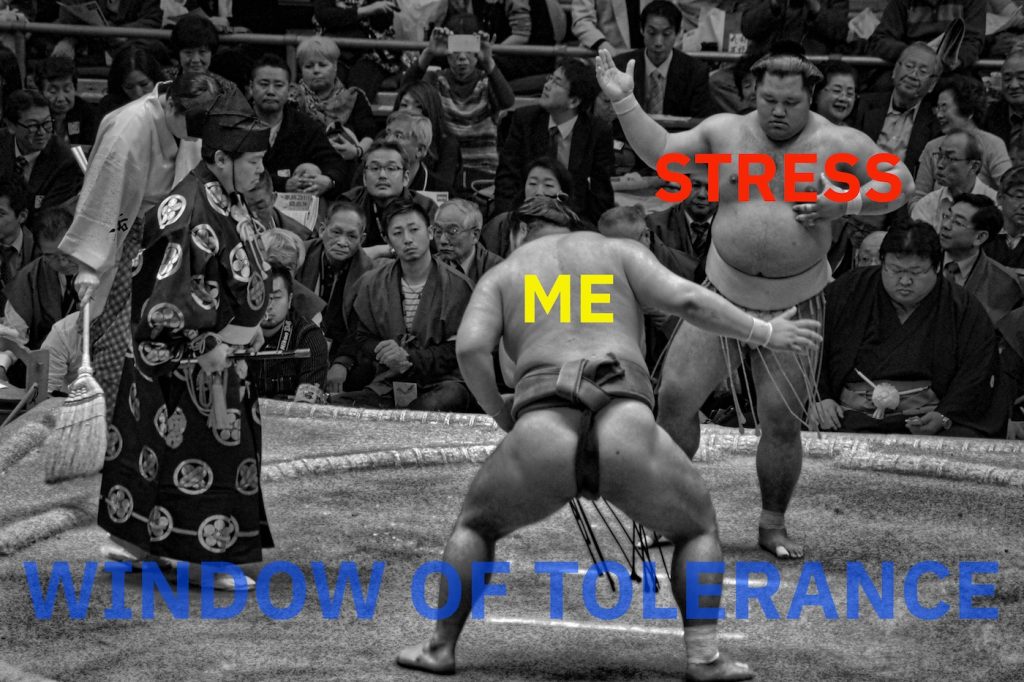The window of tolerance describes the state of being when we are calm, tranquil, and relaxed. When we are in the window of tolerance, we are functioning free from the negative impacts of stress.
Stress alters our internal frequency, pushing us out of the window. Stress drives our thoughts, feelings, and physiology toward extremes; into a state of hyper-arousal or hypo-arousal. Once we are out of the window, we become agitated or withdrawn, depending on our relationship with stress.

I hate to mix metaphors, but I visualize the window of tolerance like a Sumo ring. My stress is trying to push me out of the ring. Because my tendency is to direct stress inward and become withdrawn, my sumo stress opponent usually pushes me out of the ring and into a state of hypo-arousal. I surrender to my feelings and seek the safety of isolation. I become numb.
Here are some more words that describe the hypo-aroused state:
- Disconnected
- Auto-pilot
- Numb
- Memory loss
- Brain fog
- Lethargic
- Can’t say no
- Shut down
- Low energy
- Shame
Others are more likely to get wound up by stress. This happens to me occasionally as well. The “fight or flight” response kicks in and overloads my nervous system with racing thoughts and tension. This leads to impulsivity, hypervigilance and rage.
Here are some more words that describe the hyper-aroused state:
- Anxiety
- Impulsivity
- Overeating
- Agitated
- Shaking
- Defensiveness
- Rigid posture
- Chaotic responses
- Intrusive mental imagery
- Addictions
- Intense Reactions
AWARENESS
Which way do you tend to go when stress finally pushes you out of the window of tolerance?
Someone with a broad window of tolerance is unflappable. It takes a lot to push them out of the window or make them “lose their cool.” That’s a useful and admirable quality and luckily, it’s one we can cultivate. The first step is awareness.
Here are some more features that will help you recognize your window of tolerance:
- Feel safe
- Open and curious
- Ability to self-soothe
- Awareness of boundaries
- Ability to feel empathy
- In the moment
- Relaxed, calm, alert
- Access to intuition and insight
What does your window of tolerance look like? What are the features of that ideal, stress-free condition? What can you do to maintain that state?
INTENTION
What can you do to expand your window? Are there some stressors you could become more tolerant of? Mindfulness meditation, for instance, might help me to tolerate the dogs barking in my neighborhood. Setting clear boundaries with other people might prevent me from getting burned out socially.
Think of the window of tolerance in any emotionally charged situation. Notice when you are getting pushed one way or the other. Your goal is to stay in the window. That is the only place that you are capable of thinking clearly and acting true to yourself.
ACTION
Hyper-arousal
If you tend to become hyper-aroused, you externalize the stress by taking action, but action feeds the cycle and creates more energy. Returning to your window requires acceptance instead of impulsive action.
Hypo-arousal
If you tend to become hypo-aroused, you internalize the stress by accepting it, but avoid dealing with it. Returning to your window requires action instead of avoidance.


